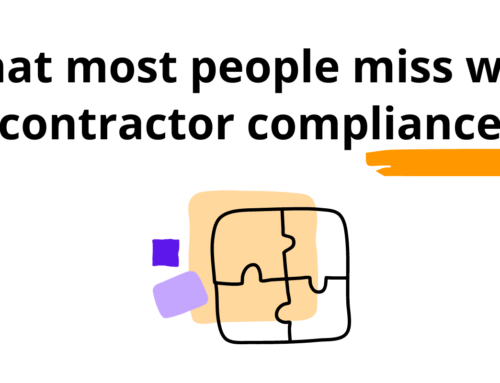Hiring contractors has a whole range of benefits for a company but it also comes with a high degree of compliance administration. Too often, businesses back away from the paperwork side of managing subcontractors that is critical to meeting your obligations. The result is a range of underlying risks that can jeopardise your business operations. Here are 7 of the most common mistakes I come across regularly.
1. Engaging a contractor without a contract
The commercial nature of contracting relationships means that a contract detailing the engagement is imperative. The idea of a hand-shake agreement between friends regularly comes un-stuck and leaves a big mess in its wake.
A simple contract that spells out the terms and conditions of the arrangement and expectations of both parties will often save you a lot of pain in the long run. Having it written down and agreed minimises disputes and creates a clear platform for everyone to get on with the job.
2. Inadequate document management

Contracting requires more documentation than most other forms of engagement and needs to be managed efficiently and appropriately. Because contracting covers a wide range of legal responsibilities and wide-ranging industries, the documents you need to collect and the frequency you need to collect them will vary.
Insurance misinterpretations are common, where a business will hire a contractor and ask for their certificate of currency, which is valid at that time. Later down the track if the business hires that same contractor and fails to get an updated certificate, the insurance may have lapsed or expired without them knowing.
Other documents like qualifications, licenses, green/white cards, subcontractor statements (NSW) etc. should all be collected and monitored to ensure compliance standards are maintained ongoing.
3. Safety oversights
Safety on a worksite is one of those non-negotiables and is highly regulated regardless of the type of worker you are engaging. Just by hiring a contractor does not pass off all your responsibilities to ensure the worksite is safe.
Essential to meeting your safety obligations will be the ability for you to prove you have taken steps in conjunction with the contractor/s to manage the safety of the site at the beginning, during and end of the job.
4. No onboarding or induction process
Each and every time you engage with a contractor it is critical to go through a consistent and transparent onboarding process to ensure all documentation is accurate and up to date. Failing to take this step or skipping important documents leaves a hole in your compliance management. While it may not be apparent straight away, all too often missed documents will come back to bite you down the line.
Induction processes are often linked to safety protocols, which are important, although inductions can be used to help bring a contractor up to speed on all aspects of a job. Incorporating into induction material your business philosophy, expectations, process and timelines can help them to see the big picture and work in with the rest of the team.
5. Incorrect worker classifications
Workers can be classified in a myriad of different ways for the purposes of different laws and regulations. Understanding where a worker sits within the legal system is no easy feat but is essential to staying on the right side of the law.
On top of the common law view of a contractor vs employee, laws that regulate superannuation, workers compensation, payroll tax and more have extended definitions that can deem certain contractors to be employees.
Take the time to gain a thorough understanding of your obligations under the different rules and get independent legal advice on your engagements or risk substantial consequences.
6. Poor contractor management policies and procedures
Many small businesses overlook the importance of having a documented process for managing the day to day engagement of a contractor. Having a written policy and procedure helps to ensure that all important documentation is identified, and a set structure is followed to maintain those standards.
Just as important as having a written policy is making sure that it’s followed by all members of your team and that it is enforced consistently. I sometimes come across a fear from businesses that they don’t want to put too much pressure on a contractor to follow protocol or the will move on. The reality is that if a contractor is not conforming to simple compliance requirements, it’s often a good thing if they move on before things go wrong.
7. Relying on individuals rather than a system to track compliance
We are all human and humans make mistakes. A system on the other hand is designed in specific ways to remove the opportunity for mistakes to happen. A simple and structured contractor compliance management system will identify and highlight important or missing information before it becomes a problem. Similarly, as individuals we tend to default to management practices we are comfortable with, meaning that each and every person has their own unique way of doing things. If compliance isn’t managed in a systematic way, it leaves too much up to personal interpretation.


